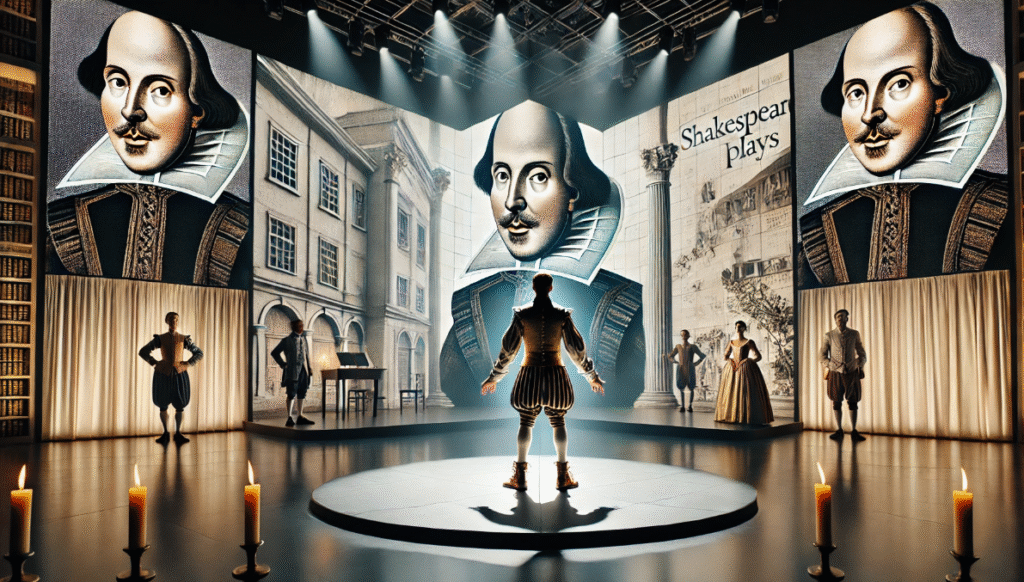
The Impact of Shakespeare on Theatre Audiences: How His Works Continue to Shape Modern Theatre Experiences
Shakespeare’s plays have stood the test of time, captivating audiences for over four centuries. But what makes his works so powerful in the modern world? 🎭 Today, the impact of Shakespeare on theatre audiences is more profound than ever, shaping how we engage with and experience theatre in ways that continue to surprise and inspire. Whether you’re a lifelong fan of the Bard or new to his world, understanding his influence on contemporary theatre can help you see productions in a whole new light.
In this article, we’ll explore how Shakespeare’s language, characters, and themes still resonate with modern audiences, and how his legacy continues to shape the theatre we experience today. Keep reading to discover how his influence can enhance your understanding and enjoyment of modern productions.
Table of Contents
Toggle1.Shakespeare’s Legacy: A Foundation for Modern Theatre
William Shakespeare isn’t just a historical figure; his influence remains at the heart of modern theatre. His works laid the groundwork for many of the storytelling techniques we still use today, making him a cornerstone of theatrical tradition. Let’s break down exactly how Shakespeare’s legacy shapes the performances you see on stage today.
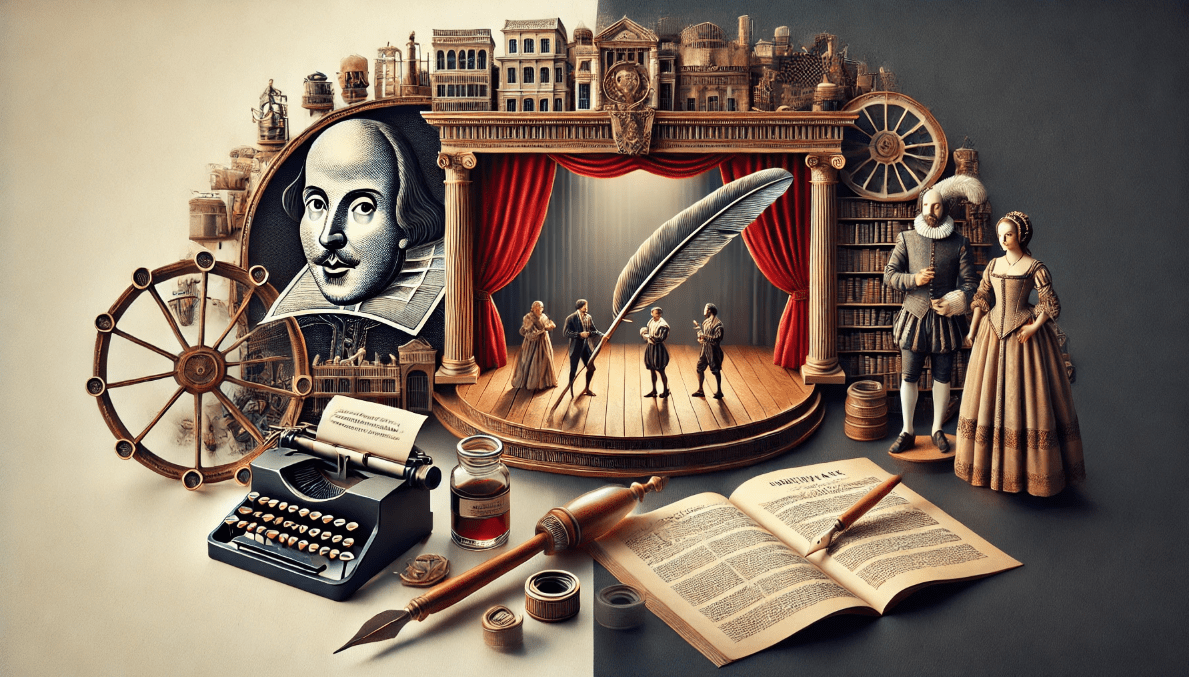
1.1 The Power of Shakespeare’s Language
One of Shakespeare’s most significant contributions to modern theatre is his mastery of language. His plays are filled with rich metaphors, beautiful soliloquies, and unforgettable dialogue that still resonate with audiences. Even today, phrases like “To be or not to be” and “All the world’s a stage” have become part of everyday speech.
👉 Practical Takeaway: If you attend a modern play, you’ll often hear echoes of Shakespeare’s distinctive style, whether through poetic language or thought-provoking monologues. By paying attention to how language is used on stage, you can trace its origins back to the Bard’s work.
1.2 Complex Characters That Stand the Test of Time
Shakespeare’s characters are multi-dimensional, with flaws and virtues that make them feel real. From the ambitious Macbeth to the witty and sharp-witted Hamlet, Shakespeare created complex personalities that modern writers and actors still draw inspiration from. His characters are relatable because they grapple with universal themes like love, jealousy, betrayal, and ambition—issues that remain relevant today.
👉 Practical Takeaway: When watching a play, notice how modern characters often reflect the complexity found in Shakespeare’s works. Whether in films, musicals, or contemporary theatre, his influence is often visible in how characters are developed and portrayed.
1.3 Dramatic Structure and Storytelling Techniques
Shakespeare was a master of structure, skillfully blending comedy, tragedy, and history. His use of plot twists, heightened emotional moments, and powerful climaxes set a standard for storytelling that is still followed in theatre today. Whether it’s a modern tragic drama or a light-hearted romantic comedy, Shakespeare’s fingerprints are everywhere.
👉 Practical Takeaway: Look at the structure of plays you enjoy. Are there moments where the tension builds toward a peak? Does the story evolve from lighthearted to serious? These techniques, first refined by Shakespeare, are still essential to how plays are written and staged.
1.4 Shakespeare’s Influence on Theatre Formats and Genres
From the historical plays that dive into the past to the heart-wrenching tragedies and playful comedies, Shakespeare’s works gave birth to many of the formats we recognize today. His influence shaped not only the genres but also the way actors perform, directors stage, and audiences engage with theatre.
👉 Practical Takeaway: Next time you watch a Shakespeare-inspired show, pay attention to the genre conventions. Whether it’s a tragic love story or a heroic journey, Shakespeare’s structural innovations are still present.
1.5 A Lasting Impact on Modern Playwrights
Shakespeare didn’t just change the way stories were told in his time—he paved the way for countless playwrights who followed. Modern theatre writers often credit Shakespeare as a source of inspiration, using his themes, character archetypes, and even his language as a framework for their own work.
👉 Practical Takeaway: Many contemporary plays and movies you enjoy may carry a piece of Shakespeare’s legacy. Understanding this connection can help you appreciate the evolution of modern storytelling, as it often builds on the Bard’s original ideas.
2. Shakespeare’s Impact on Theatre Audiences: What Has Changed and What Has Stayed the Same?
Shakespeare’s works have endured for over 400 years, captivating audiences across the globe. While some aspects of how we engage with his plays have changed, others remain timeless. In this section, we’ll explore what has evolved in the theatre experience and what still draws audiences to Shakespeare today.
2.1 How Theatre Audiences Have Changed Over Time
Audiences today are quite different from those who filled the Globe Theatre in Shakespeare’s time. Back then, theatre was a popular, communal experience, often attended by a diverse crowd. People from all walks of life gathered together, sometimes standing in the “pit” for hours to see a show. However, modern audiences are more likely to be seated in comfortable theatres, and performances tend to attract more specific demographic groups, from theatre enthusiasts to casual visitors.
- Diverse Demographics: Today’s audiences are more diverse, with people from various backgrounds, ages, and cultures attending performances.
- More Accessibility: Thanks to digital platforms and accessible performances (e.g., live-streaming, subtitles), audiences from around the world can now enjoy Shakespeare’s plays without having to travel.
👉 Practical Tip: When attending a Shakespearean performance, you’ll notice that different groups—whether students, tourists, or local theater-goers—now enjoy the show, which can create a richer, more varied audience experience.
2.2 The Role of Technology in Shaping Audience Experiences
Theatre has come a long way from candlelit stages. Today, advanced lighting, sound effects, and multimedia presentations bring Shakespeare’s works to life in new ways. While Shakespeare’s plays relied heavily on the power of language and actor performance, modern productions often use digital effects and immersive visuals to enhance storytelling.
- Digital Enhancements: The use of projections, sound design, and live streaming allows audiences to experience Shakespeare in innovative ways.
- Immersive Performances: Interactive theatre, where the audience becomes part of the play, is a growing trend, creating a more engaging, participatory experience.
👉 Practical Tip: Pay attention to how modern adaptations of Shakespeare’s plays incorporate technology. Whether it’s a projected castle in Macbeth or high-tech sound design in Hamlet, technology brings a fresh layer to the experience.
2.3 What Has Stayed the Same? The Timeless Appeal of Shakespeare’s Themes
Despite all the changes in theatre, Shakespeare’s core appeal remains unchanged. The themes in his plays—love, power, betrayal, jealousy, and ambition—continue to resonate deeply with modern audiences. Whether it’s the tragic downfall of Hamlet or the rivalry between Othello and Iago, Shakespeare’s exploration of human nature feels just as relevant now as it did in the 1600s.
- Universal Emotions: Shakespeare’s ability to capture the complexities of human emotions remains one of his greatest legacies. His works are relatable across cultures, time periods, and generations.
- Engaging Storylines: At their core, Shakespeare’s plays are compelling stories that continue to captivate audiences. His mastery of conflict, character development, and plot structure means that his works never lose their emotional punch.
👉 Practical Tip: Even in modern adaptations, you’ll often find that directors stay true to the essence of Shakespeare’s stories because the underlying themes still speak to universal human experiences. When attending a performance, notice how these timeless ideas continue to draw audiences in.
2.4 How Shakespeare Still Challenges Audiences
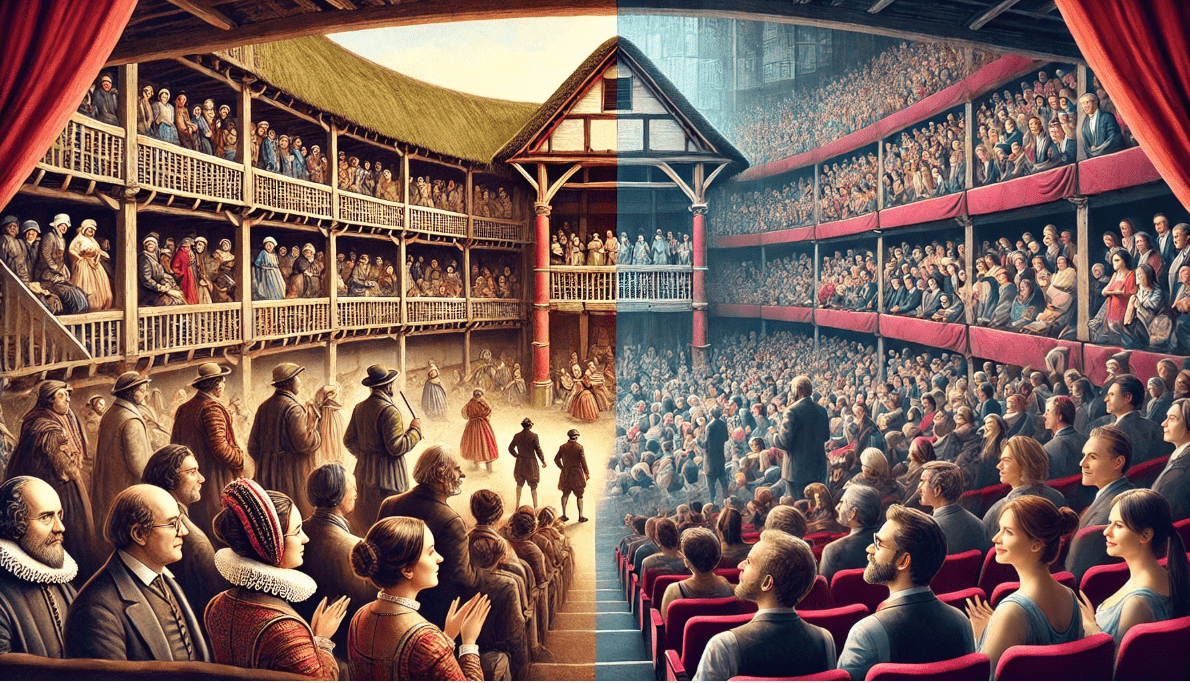
While the way audiences engage with theatre has evolved, Shakespeare’s works remain complex, challenging, and thought-provoking. His use of intricate language, deep psychological insight into characters, and sometimes ambiguous moral messages still demand active interpretation from today’s audiences.
- Challenging Language: While modern versions may use simpler language, Shakespeare’s original texts often require focused attention to fully appreciate.
- Layered Meanings: Shakespeare’s works contain numerous layers of meaning, requiring the audience to interpret the characters and plot in multiple ways.
👉 Practical Tip: If you’re attending a traditional Shakespeare production, don’t be afraid to dive deeper into the meaning behind the words. Ask yourself why a character acts a certain way or what the play’s themes reveal about society and human behavior.
3. Practical Insights: How Theatre Professionals Use Shakespeare’s Influence to Engage Audiences
Shakespeare’s works are a powerful tool for theatre professionals looking to engage modern audiences. His stories, characters, and themes are rich in emotion and complexity, making them perfect for captivating today’s viewers. In this section, we’ll explore how directors, actors, and designers use Shakespeare’s influence to create memorable, impactful performances that resonate with modern audiences. 🎭
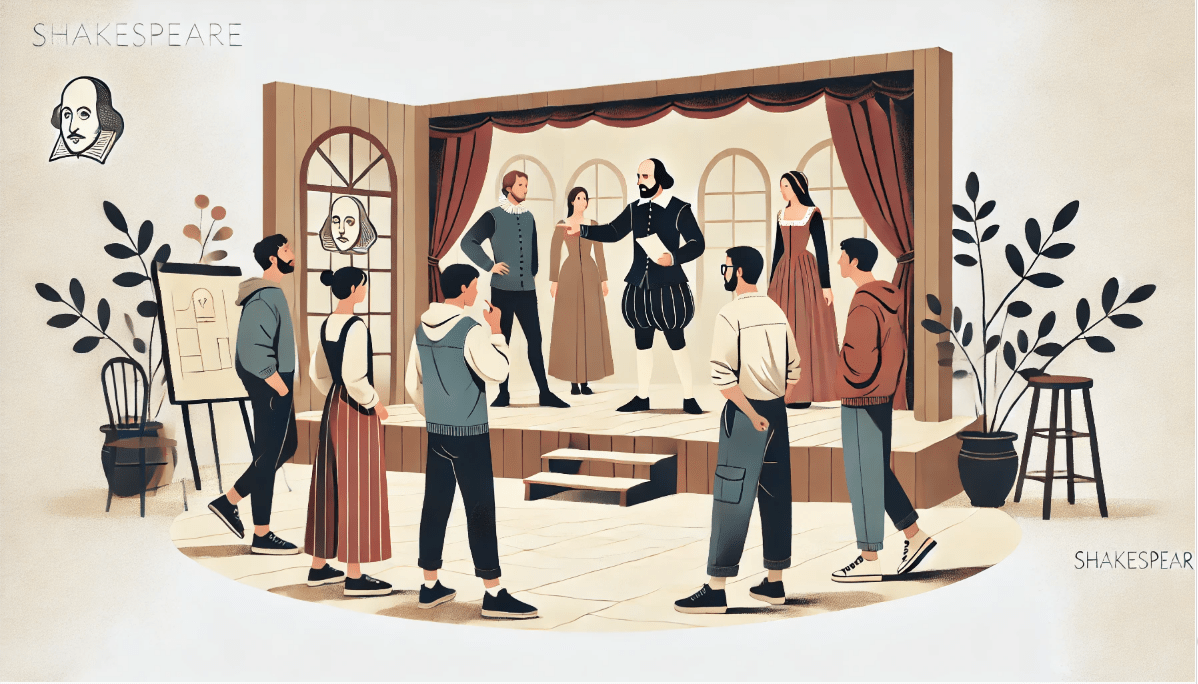
3.1 Modern Staging Techniques Inspired by Shakespeare
Theatre professionals often look to Shakespeare’s minimalist approach to set design and staging, which leaves room for creativity and imagination. Many modern productions take inspiration from this, blending traditional elements with contemporary flair.
- Minimalist Set Designs: Just like in Shakespeare’s time, many modern productions use simple, yet powerful sets that focus on the actors and their performance. This allows the story to take center stage without distractions.
- Symbolic Elements: Shakespeare often used symbolic props or minimal set pieces to convey deep meanings. Today’s directors use similar techniques to represent complex themes—think of how a single prop or light can suggest a world of meaning.
👉 Practical Tip: Pay attention to how modern productions use subtle set changes to reflect emotional shifts or thematic developments in the play. The set might be sparse, but every piece will often carry a deeper significance.
3.2 Creative Costume Design and Visuals
Shakespeare’s time saw elaborate costumes that reflected the status and personality of characters. Modern costume designers still draw on this tradition, using clothes not only for aesthetic value but also to convey character traits and themes.
- Modern Adaptations: Many productions use contemporary clothing to set Shakespeare’s stories in modern contexts. For example, Romeo and Juliet may be staged with the characters dressed in modern-day attire, making the themes of love and violence even more relatable.
- Visual Metaphors: Just as Shakespeare used visual cues to signal a character’s arc (e.g., a crown for a king), modern designers create costumes that tell stories. A costume’s color, texture, or form can indicate power dynamics, personal struggles, or even the internal conflicts of a character.
👉 Practical Tip: When watching a Shakespeare-inspired performance, notice how the costumes reflect each character’s journey. Are there changes in their attire as their emotional state or social position shifts?
3.3 Engaging the Audience: Interactive and Immersive Theatre
One of the most exciting trends in modern theatre is the shift towards immersive and interactive performances, and Shakespeare’s works lend themselves perfectly to this. The stories of betrayal, power, and love feel even more intense when the audience becomes part of the action.
- Audience Participation: Directors are increasingly incorporating the audience into the performance, whether through direct interaction or by making the audience feel as if they are part of the world on stage. This can turn a typical play into a memorable experience where the audience feels personally invested in the characters’ fates.
- Immersive Productions: Imagine walking through the streets of Verona as Romeo and Juliet unfolds around you. Immersive Shakespeare productions often place the audience in the middle of the action, creating an unforgettable experience that blends theatre with live-action storytelling.
👉 Practical Tip: If you’re ever part of an immersive Shakespeare experience, take full advantage of your surroundings! Engage with the actors, observe the details, and allow yourself to be drawn into the story.
3.4 Using Technology to Enhance the Experience
Modern technology has transformed theatre, and Shakespeare’s works are no exception. From digital projections to innovative sound design, technology can deepen the emotional impact of a production and bring Shakespeare’s world into the 21st century.
- Digital Projections and Effects: Directors may use digital projections to create stunning backdrops, enhance the mood, or bring elements of the play (like ghosts or supernatural events) to life in ways that Shakespeare himself could only have dreamed of.
- Soundscapes and Music: Sound design plays a huge role in creating atmosphere. In Shakespeare’s plays, music often set the tone for key scenes. Today, sound effects, modern scores, and even live music can elevate the emotional impact of a performance.
👉 Practical Tip: Focus on how sound and visuals are used in a production. Notice how music and special effects help deepen your emotional connection to the characters or heighten the drama in pivotal moments.
4. How Shakespeare’s Works Continue to Shape Theatre Education and Training
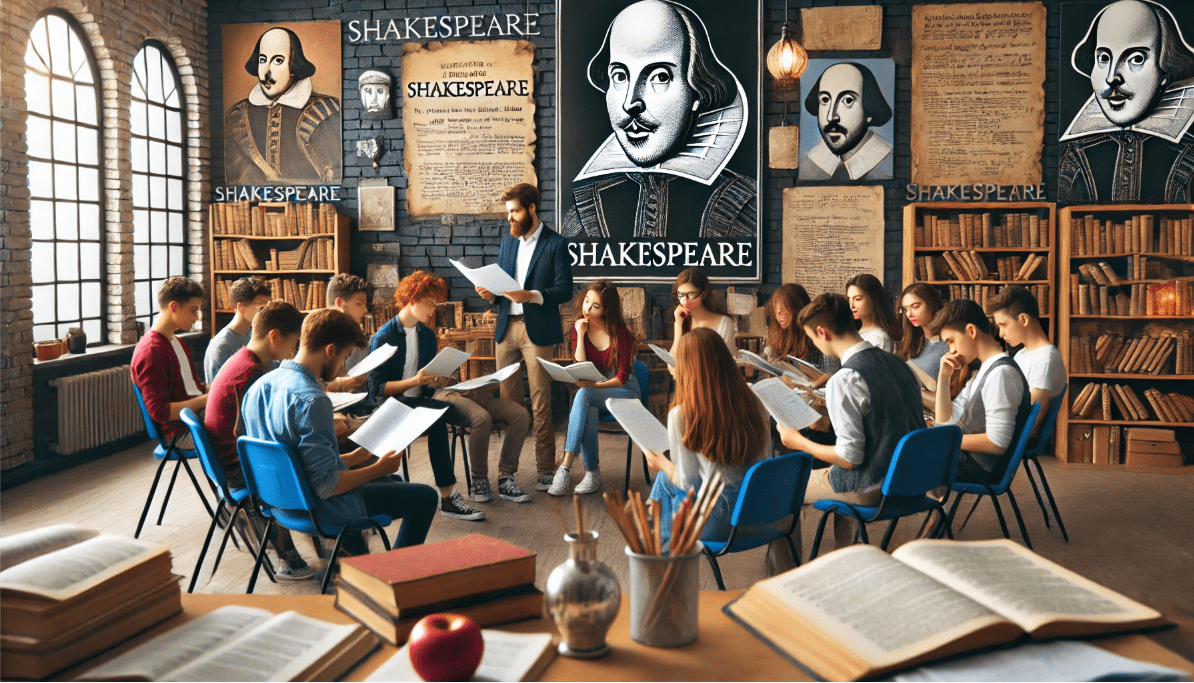
Shakespeare’s influence extends far beyond the stage—it is deeply embedded in theatre education and training. For aspiring actors, directors, and playwrights, learning and performing Shakespeare’s works is a rite of passage. His plays offer a unique opportunity to hone skills, explore complex themes, and gain a deeper understanding of the art of theatre. Let’s take a closer look at how Shakespeare continues to shape theatre education today. 🎓
4.1 Shakespeare as a Cornerstone of Theatre Education
For any actor or theatre student, Shakespeare’s plays are essential learning material. His works offer rich texts that challenge students to understand and master complex language, character development, and dramatic structure. Shakespeare’s influence is part of the foundation in many drama programs around the world.
- Language Mastery: Shakespeare’s intricate language teaches actors how to navigate complex dialogue, use rhythm and tone effectively, and deliver lines with precision.
- Character Depth: Understanding Shakespeare’s characters requires deep emotional and psychological insight, which helps actors develop their craft and bring characters to life in a meaningful way.
👉 Practical Tip: If you’re training in theatre, practicing Shakespearean scenes can strengthen your skills in interpretation and delivery, while pushing you to expand your range as an actor. Embrace the challenge—it will make you a better performer.
4.2 Shakespeare’s Influence on Modern Playwriting and Direction
Shakespeare’s influence extends to directors and playwrights as well. His ability to weave compelling plots, create multi-dimensional characters, and explore universal themes makes his works a goldmine for directors looking to understand the heart of storytelling.
- Storytelling Techniques: Shakespeare’s use of plot twists, dramatic irony, and tension-building techniques continues to influence how modern playwrights structure their stories.
- Directorial Vision: Directors often turn to Shakespeare to learn how to bring a complex narrative to life on stage, focusing on character dynamics, pacing, and emotional arcs.
👉 Practical Tip: If you’re working in theatre direction or writing, analyzing Shakespeare’s works will deepen your understanding of how to build tension, create strong characters, and craft a narrative that keeps an audience engaged.
4.3 Shakespeare’s Role in Theatre Training: Building Confidence and Versatility
Shakespeare’s plays require actors to explore a wide range of emotions, from the heights of joy to the depths of tragedy. This versatility helps actors build confidence, adaptability, and emotional intelligence.
- Emotional Range: Shakespeare’s plays are a treasure trove of emotional depth. Whether you’re portraying a heroic figure or a tragic villain, his characters allow actors to express an array of emotions and grow in their emotional range.
- Performance Techniques: Shakespeare’s work also demands a high level of vocal and physical control. Actors often focus on projection, enunciation, and body language when performing his works, which enhances their overall stage presence.
👉 Practical Tip: Training with Shakespeare’s works improves your ability to adapt to various roles, whether on stage or in film. It also gives you the tools to tackle different genres with confidence.
4.4 Shakespeare in Theatre Education: A Global Influence
Shakespeare’s influence in theatre education isn’t limited to English-speaking countries. His works have been translated into countless languages and are studied worldwide. His universal themes of love, power, and morality resonate with audiences and students from different cultural backgrounds.
- Global Appeal: Shakespeare’s works are often used to teach not only theatre skills but also cultural appreciation, making them a bridge between different traditions and practices.
- Cross-Cultural Interpretations: The way different cultures approach and adapt Shakespeare’s works in their own context fosters a rich diversity in theatre education. From Bollywood’s Macbeth to Japanese theatre adaptations of Hamlet, Shakespeare’s plays continue to inspire creative reinterpretations worldwide.
👉 Practical Tip: If you’re studying theatre, exploring how Shakespeare’s plays are interpreted in other cultures can broaden your perspective and inspire fresh approaches to performance and storytelling.
5. The Future of Shakespeare in Theatre: What’s Next for Audiences and Performers?
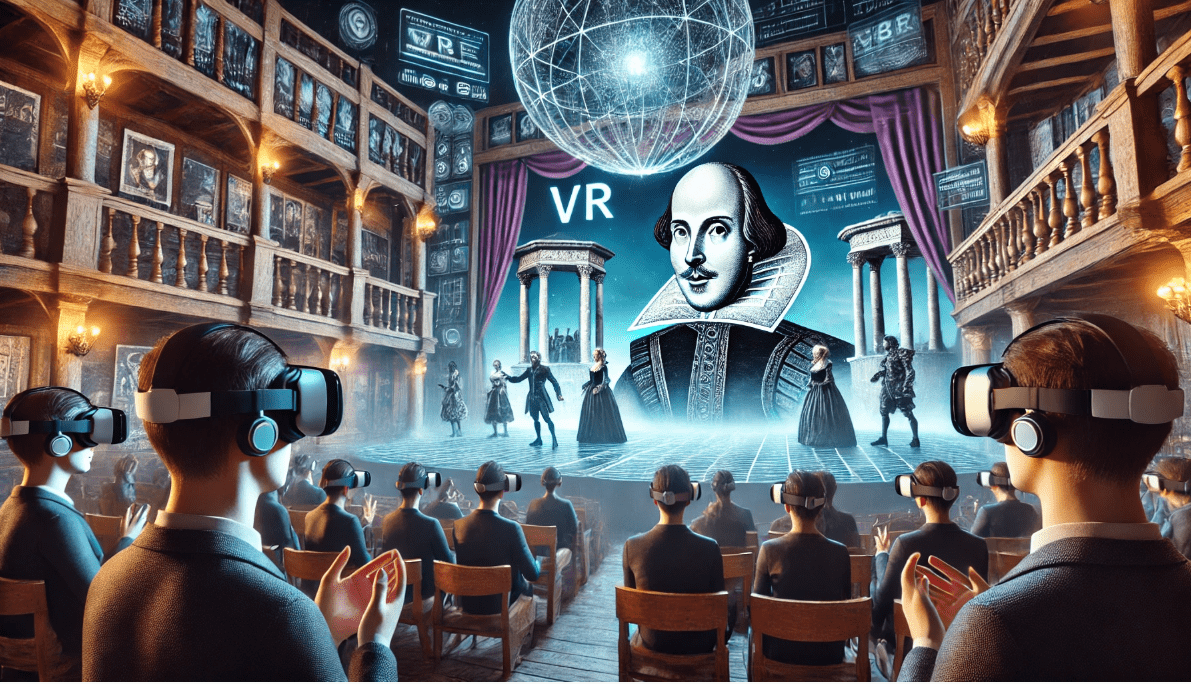
Shakespeare’s works have endured for centuries, but what does the future hold for his plays in modern theatre? As we move further into the 21st century, both audiences and performers continue to explore new ways of experiencing the Bard’s timeless stories. In this section, we’ll look at how Shakespeare’s legacy is evolving in theatre and what exciting trends lie ahead. 🌟
5.1 Digital and Virtual Theatre: Shakespeare in the Digital Age
One of the most significant shifts in modern theatre is the rise of digital and virtual performances. Technology is opening up new ways for audiences to experience Shakespeare, from live-streamed performances to virtual reality (VR) experiences.
- Live Streaming: Theatre productions are now more accessible than ever, with live-streaming events bringing Shakespeare’s plays to global audiences. Whether you’re watching a Royal Shakespeare Company performance from your home or a local production broadcast online, digital platforms are making it easier for fans to experience the magic of Shakespeare.
- Virtual Reality and Immersive Experiences: Imagine stepping into the world of Macbeth or A Midsummer Night’s Dream using VR. As VR and AR technology advance, theatre companies are experimenting with immersive experiences that allow audiences to engage with Shakespeare’s plays like never before.
👉 Practical Tip: If you’re a fan of theatre or a performer, consider how digital platforms can help you access new productions. Virtual reality might also provide a unique way to train and rehearse for performances, offering a new layer of depth to your craft.
5.2 Global Adaptations: Shakespeare for Every Culture
Shakespeare’s works have always been adaptable, and in the future, we can expect even more cross-cultural interpretations of his plays. Directors around the world are reimagining Shakespeare in diverse cultural contexts, making his stories relevant to different audiences.
- Cultural Reinterpretations: From Bollywood’s Macbeth to Chinese adaptations of Hamlet, Shakespeare’s themes of love, power, and betrayal resonate across borders. This trend is likely to grow, as theatre companies continue to find new ways to integrate Shakespeare into their own cultural narratives.
- Inclusive Casting: Diverse casting has already become a key feature of modern productions, and we’ll likely see even more inclusivity in the future. Expect to see more productions where race, gender, and cultural identity are explored through Shakespeare’s characters.
👉 Practical Tip: Keep an eye out for international adaptations of Shakespeare’s plays. These reinterpretations offer a unique perspective on his stories, often bringing fresh insights into the characters and themes you thought you knew.
5.3 The Future of Shakespearean Acting: Technology and Performance Techniques
The role of technology in enhancing actor training and performance is set to continue evolving. From motion capture to augmented reality, tech tools are enhancing how performers engage with Shakespeare’s complex roles.
- Motion Capture and Digital Performance: In the future, actors might use motion capture technology to perform Shakespeare’s plays in a digital format, creating animated versions or virtual performances with cutting-edge realism.
- Advanced Performance Techniques: Performers will continue to push the boundaries of physical and emotional performance. Expect more innovative ways to express the heightened emotions in Shakespeare’s works through experimental acting techniques, physical theatre, and movement-based performances.
👉 Practical Tip: As a performer, explore how technology like motion capture or augmented reality can enhance your practice. These tools could revolutionize the way you approach rehearsals and stage performances, adding a new dimension to your craft.
5.4 Shakespeare’s Enduring Relevance: Themes That Continue to Speak to Modern Audiences
Despite the changes in technology and culture, Shakespeare’s works will continue to speak to modern audiences. His exploration of universal themes—love, jealousy, ambition, and betrayal—remains as relevant today as it was in the 16th century.
- Relevance in a Modern World: Issues like power dynamics, gender equality, mental health, and social justice are explored in Shakespeare’s plays, and these themes will continue to resonate with audiences facing similar challenges today.
- New Interpretations and Focus: Future productions may shift focus on underrepresented characters or themes within Shakespeare’s works, offering new interpretations that reflect modern societal issues.
👉 Practical Tip: As you engage with Shakespeare’s plays, pay attention to the modern relevance of the themes. You may notice that directors and actors are highlighting social or political issues in ways that speak to current events, making the Bard’s works feel more timely and urgent.
6. The Unbroken Bond Between Shakespeare and Modern Theatre Audiences
Shakespeare’s works have been captivating audiences for centuries, and that bond remains as strong as ever today. Despite the many changes in theatre and society, the connection between the Bard’s plays and modern audiences is unbroken. In this section, we’ll explore why Shakespeare’s works continue to resonate deeply with viewers and how this enduring relationship shapes the theatre experience today. 🌟
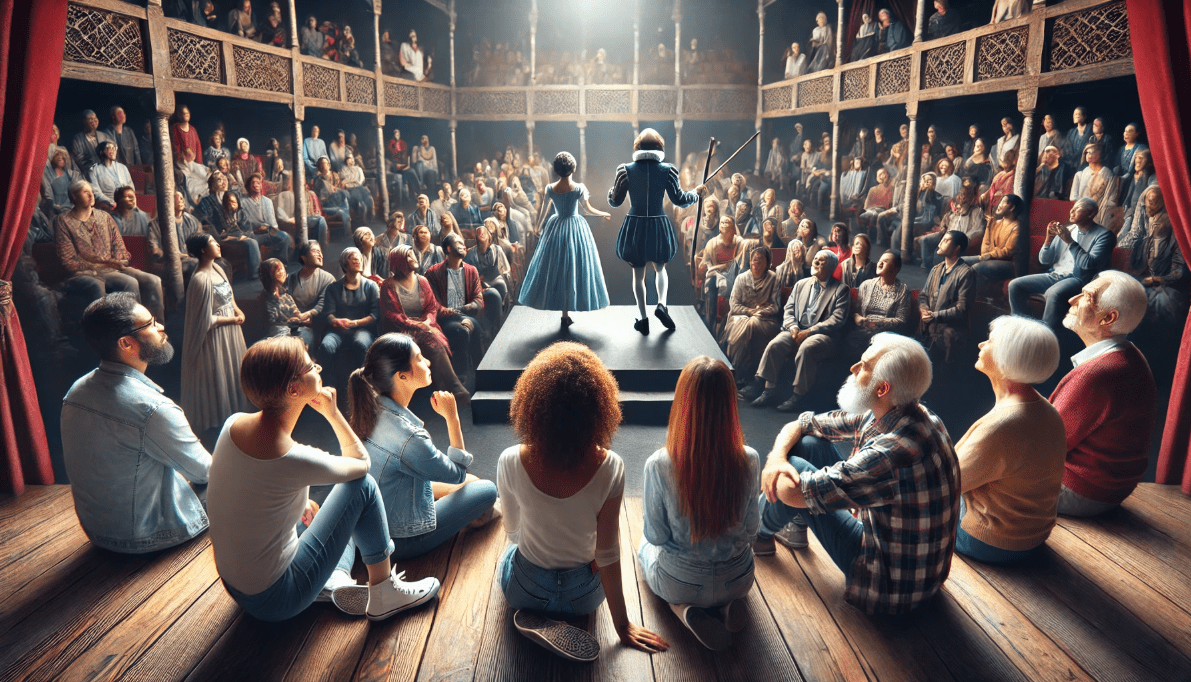
6.1 Universal Themes That Speak to All Generations
At the heart of Shakespeare’s lasting appeal is his ability to tap into universal human experiences. Themes like love, power, ambition, betrayal, and morality transcend time and culture, making his works just as relevant to modern audiences as they were to those of his time.
- Timeless Relevance: Whether you’re watching Macbeth and reflecting on ambition, or experiencing Romeo and Juliet’s exploration of love, these themes continue to touch on deep emotions that everyone can relate to.
- Cultural Reflection: Shakespeare’s characters are multi-dimensional and represent the complexities of human nature, which makes them feel just as real and compelling today as they did 400 years ago.
👉 Practical Tip: When attending a modern Shakespearean performance, think about how the themes in the play relate to today’s world. You might find parallels to modern politics, social justice issues, or personal relationships.
6.2 The Power of Shakespeare’s Language
One of the most significant ways Shakespeare continues to connect with modern audiences is through his language. While the vocabulary might be old-fashioned, the beauty, rhythm, and emotional power of his words remain unmatched. The depth of his dialogue invites the audience to think critically, feel deeply, and engage actively with the performance.
- Poetic Language: Shakespeare’s mastery of language is a big part of what makes his works so compelling. His ability to craft memorable soliloquies and create emotional tension with words draws audiences in and keeps them engaged.
- Emotional Impact: Even if the language is challenging, it’s often the emotional resonance of Shakespeare’s words that moves audiences, providing a connection that lasts long after the curtain falls.
👉 Practical Tip: If you’re new to Shakespeare, try reading along with the performance or watching a modern adaptation to help break down complex language. Understanding the emotion behind the words can make the experience much more enjoyable.
6.3 Engaging Performances and Interpretations
The way Shakespeare’s plays are interpreted on stage continues to evolve, but the core of his works remains unchanged. Directors and actors often bring fresh perspectives and innovative interpretations to his plays, ensuring that they resonate with modern sensibilities while maintaining their timeless essence.
- Creative Adaptations: From modernized settings to diverse casting, directors and theatre companies continue to reinterpret Shakespeare’s stories, making them feel new and exciting.
- Emotionally Relevant Performances: Skilled actors understand the depth of Shakespeare’s characters and bring them to life in a way that makes their struggles and triumphs universally relatable.
👉 Practical Tip: Keep an eye out for unique interpretations of Shakespeare’s plays—whether through new settings or fresh casting choices, these adaptations help keep the connection to Shakespeare’s works alive and vibrant for today’s audiences.
6.4 The Enduring Popularity of Shakespeare Festivals and Productions
The global popularity of Shakespeare festivals and productions speaks volumes about the lasting bond between his work and modern audiences. From small local performances to major international festivals, Shakespeare’s works continue to draw massive crowds, and this trend shows no signs of slowing down.
- Community Engagement: Shakespeare festivals often create a sense of community, where people of all ages and backgrounds come together to enjoy timeless stories. The shared experience of watching a live performance strengthens the connection to the material.
- Wide Accessibility: With performances available on streaming platforms, at outdoor theatres, and through immersive experiences, Shakespeare remains accessible to more people than ever before.
👉 Practical Tip: Attending a Shakespeare festival or watching a live-streamed performance can deepen your connection with the material. It’s an excellent way to experience his works with an audience that shares your enthusiasm.
Shakespeare’s influence on theatre audiences is nothing short of remarkable. From his masterful use of language and complex characters to his universal themes, his works continue to captivate, challenge, and inspire audiences across the globe. Whether you’re attending a modern adaptation, immersing yourself in a traditional performance, or exploring Shakespeare’s impact on theatre education, it’s clear that his legacy remains a vital force in the world of theatre.
As we’ve seen, while the way we engage with Shakespeare may evolve—thanks to technology, diverse adaptations, and global interpretations—the heart of his work remains timeless. His themes continue to resonate with contemporary audiences, and his ability to portray the complexities of human nature ensures that his stories will remain relevant for generations to come. 🎭
Frequently asked Questions (FAQs)
1. Why is Shakespeare still relevant in modern theatre?
Shakespeare’s works remain relevant because they explore timeless human emotions and themes, like love, power, betrayal, and ambition. His complex characters and intricate plots continue to resonate with today’s audiences, making his plays adaptable to modern-day issues and societal concerns.
2. How has Shakespeare influenced modern theatre performances?
Shakespeare’s influence is seen in modern theatre through his storytelling techniques, like dramatic tension, plot twists, and character development. Directors often draw on his works to create powerful emotional experiences, while actors continue to perform his iconic roles, refining their craft through his challenging dialogue and complex characters.
3. What role does Shakespeare's language play in contemporary theatre?
Shakespeare’s language, though old-fashioned, is powerful and poetic, creating a rich emotional experience for audiences. Modern productions often use his language to highlight universal themes, while adaptations may simplify it to make the dialogue more accessible, ensuring its continued appeal.
4. How do modern adaptations of Shakespeare’s plays differ from traditional productions?
Modern adaptations often update Shakespeare’s settings, costumes, or even characters to make his stories more relatable to current audiences. Directors may set a play in a contemporary environment or change cultural contexts, but they maintain Shakespeare’s core themes and emotional depth.
5. How does Shakespeare’s influence extend beyond English-speaking countries?
Shakespeare’s works have been translated into numerous languages and adapted by theatre companies worldwide. His universal themes make his plays adaptable to different cultural contexts, allowing directors to reinterpret his stories in ways that resonate with global audiences.
6. Why are Shakespeare’s plays important in theatre education?
Shakespeare’s plays are crucial in theatre education because they teach actors and directors how to master complex dialogue, develop multi-dimensional characters, and understand timeless storytelling techniques. They challenge students to explore deep emotional ranges and refine their craft, making them an essential part of any theatre program.
7. How do Shakespeare’s works engage modern theatre audiences?
Shakespeare’s works engage modern audiences through their emotional depth, relatable characters, and universal themes. Directors and actors often modernize the plays by incorporating new technologies, diverse casting, or immersive experiences to make them more engaging and relevant to today’s viewers.
8. What are the future trends in how Shakespeare’s works will be performed?
The future of Shakespeare in theatre involves incorporating digital technology like virtual reality (VR), live streaming, and immersive performances. These innovations will allow audiences to experience his works in new ways, creating more interactive and accessible theatre while preserving the core themes that make Shakespeare timeless.
